This is a transcript version of my talk for the 2nd Symposium on Digital Art in Ireland in University College Cork, presented June 14th 2024.
Abstract - January
I asked visitors in an online forum, "What is home", and I received several replies "It's where you are", "It's who you are", "It's someone else", "It's what you remember", "You lose it to find it again", "Its a place with a toilet you like". Homes seem to interact with the voids between an individual, a structure and a community.
Interaction is the basis of digital experience; you press a key, and electricity responds like magic. Magic exists in mystery, mystery in the unseen responder, and digital art exists in the void between the request and response.
In video games, the art exists in the sense of embodiment, or the feeling that the human spirit is divided between the physical, the imaginary, and the digitally represented. Art does not make you whole, but it does inhabit the void between those separate identities. Art allows the game to suspend reality long enough to create an alternate world.
Two years ago at this conference, I spoke about the web and the resurgent folk craft of homepages as gateways to digital art. I described digital art as a series of journeys through virtual worlds.
As part of my current project (The Chaos Layout Generator), I will return to those journeys and discuss how my ideas surrounding web-based and interactive art have evolved over the past year.
The Chaos Layout Generator is a website that guides people into creating chaotic and unstructured homepages. Its goal is to contextualise the browser as an artistic medium and express the belief that the web is an extension of humanity and must represent humanity's messy, colourful and inexplicable need for chaos and reinvention.
This paper will discuss the ideas of chaos, interaction, play, embodiment and home as aspects of digital art and some of the questions I've encountered as part of this project and within the web art scene as a whole.
Note this talk did not end up discussing the chaos project directly, but became more of a general overview!
Talk - June
I asked some strangers in an online forum “Where is home?” and I received a selection of answers: Home is where you feel safe, its where your friends are, and its where there’s a toilet you like – home is where the grass is green and the girls are pretty, home is a wi-fi network you auto connect to, home is an idea and a place and a time and a purpose.
What you’re looking at it my homepage, but there are others! I briefly showed you this site two years ago at the last digital conference; but a lots changed since then and I felt it was worth returning to.
In web-based art, purpose is like a ghost that stands over our beds in the night, asking for its name. We often ask ourselves; are useless websites acceptable? When we scrape away the polite accessibility features and middle-class pretences to a job at Google, whats really left?
Digital art is a non-linear memory of an experience that may someday manifest on your laptop or phone. It can only be a promise, and like all promises, it can be aspirational, deceitful, wonderful, and it can be broken, realised or compromised over and over.
I find myself orbited by these quandaries, as I try, exhaustingly to justify my worth; but home does not have these questions and home doesn’t have the answers. Home is the place where the questions are irrelevant, its where the fear of wanting to belong fades like the day.
Like dreams of school and polished floors that were only temporary to begin with; obsolete technology sits in the shed waiting for a home that excised decades ago. You have no choice, you will accept the path technology takes because there is no other path, there never was and there never could be.
But somehow, through a series of unintentional events, I find myself here, still unable to accept the comfortable life that a degree in Computer Science from UCC offered and quietly suffering while rest of society buys their three euro Americanos. I can only dream about projects that were born out of failed exams, summer holidays and half-baked memories of an internet that was loveably silly and shrouded in forbidden unknown futures.
.*~ Video Games
Before getting into anything else, I wanted to take you back to 2013, when I used to run a small public Minecraft server. Minecraft is a videogame where you can work with other players to build things using 3D pixels or voxels. It was one of the first games to break out of the gaming industries techo-fetishism for high-definition graphics, and was the darling of the indie gaming community before being bought by Microsoft.
I still get occasional emails from people who played on my servers back in 2013 and who remember them as defining times in their childhoods. Sometimes they ask if I still have the old save file so they can explore their long lost homes and I’m always pleased to say that I do! Its lovingly preserved on an Amazon S3 server hosted just outside of Dublin.
Its stored in this building to be exact; Northern Europe AWS datacenter 1, just north of Blanchardstown; this is where your home is!

In preparation for this talk, I took some time to explore the save file myself and found some homes to show you. They remain mostly intact after a decade, preserved like an electric Pompeii, with their doors sometimes left open and waiting for residents to return.

As I explored; changes in the games code meant that fires started to spread and after a frozen decade the houses in that world started to burn down. My observation became destruction and I started to wonder if my presence in this world was still welcome.
A digital file has very little grasp on the concept of time, but temporal data has an emotional impact and I can’t help but feel like each binary instant in a computers mind is like the rolling blackouts of forgotten summer hopes. Teen pop culture, in any format is not about an artist or a subject, it’s about acts of shared experience that will become the defining reference points of future lives.
.*~ Digitality
Likewise these artifacts and fragments are not the paraphernalia of the time in which we live. Idols and fandoms for mass media are the embodiment of ourselves. I am this page, I am that video game, I am those figures spinning on the screen, I am the screen, I am the internet and so are you. This becomes a slight issue when people start to discuss copyright online; how can you copyright part of my soul?
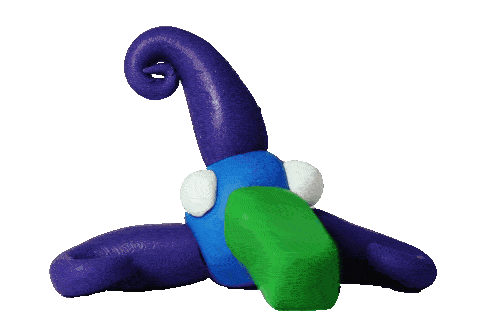
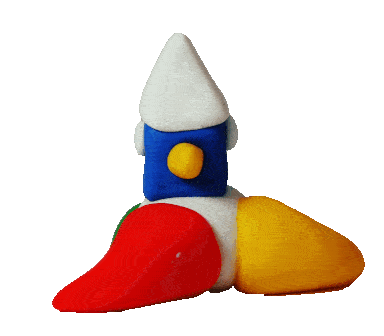
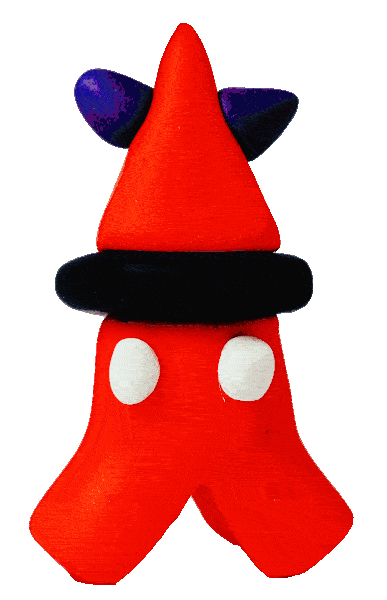
Zorbs are loosely remakes of figures I used to make in primary school. Unlike those Minecraft houses, these Zorbs did not survive as timeless digital files, but as muscle memory and polymer clay sitting on the shelf of Cork Art Supplies. When I click one of these Zorbs it will be downloaded to this computer and for the rest of this symposium you should remember that there’s a little Zorb sitting just out of sight in the computers memory.
Were these Zorbs destine to be digital art from the start? Did they become digital art when I put them on my site, or did they only just become digital art now, at this moment.
Digital art exists somewhere out on the network, outside of my hands, outside of the servers that hold its code – the art is held in suspended animation, in the dividing line between interaction, life and technology. It’s not the streamer, the streaming, the stream or the audience that matters. Like humour, digital art is only alive in zeitgeist of memory; digital art is like chuckling at a joke you heard ten years ago; when the rolling instants of binary summers collapse for a moment, and you find yourself at home, and then you leave again.
In early 2023 I took some time to finish a project (Ozwomp is Online) that had originally been a collaboration with other netizens; Electra, Cinni, Pirik, Dantescanline and deceased netizen, Frank Lenon who passed away in 2008 and who’s website of early 90s midi music has somehow remained online. This game is memory of a video game as much as it is a video game. It’s incomplete and has no beginning or end, it exists sometime in the afternoon of Christmas day, when the day seems to go on forever and life is nothing but tea and frosted cake; its an endless pause screen on an abandoned PlayStation 2, while the world does something more important somewhere else.
As you explore its space, you encounter strange beings who mostly seem to have priorities of the own; around you in the sky are celestial MiniDisks that contain quotes and phrases from pomes that where never actually written. Beside you is a small friend called a Plattyhoop, you’re not really sure why he follows you or why no one else can see him. Other people who visit this world will appear on your screen too, and you can leave hearts that float in space for a while; but like you, they vanish not long after your browser window closes.
.*~ Spaces
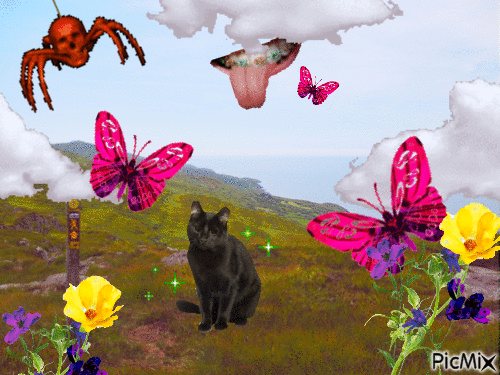
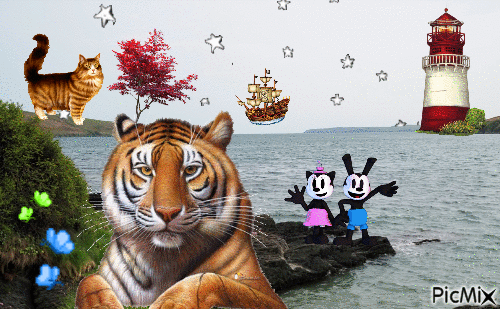
On the left is my lovely hike; as I remember it at least. A photograph failed to capture the feeling of lighthearted freedom I had that day walking for six hours on Sheep’s Head. It was the hottest day of the year and no one else was there. When I think back on that hike though I wasn’t alone; there were the clouds and those teeth in the sky and the sinister spider.
In contrast, on the right, my time sitting by the sea in Kinsale was far moodier. I was expecting big news and on the horizon storms threatened and haunted ships rose from the depths while the vast cats gathered. Should I really trust those Disney mice, they seem awfully welcoming but I don’t like the look of the water.
If you are unfamiliar with the site, these images are PicMixes. PicMix is a website that lets you augment photos with animated gifs, glitter and sound – while sharing your mixes with the community and voting on the best mixes of the month. I brought it up here because I suspect during the course of this symposium you’ll have seen your fair share of digitally augmented images and I wanted to argue that there is no technological hierarchy in digital augmentation. There is no mythical new technology that will create the new unknown masterpiece. Every image is a simple matrix of luminance values, each as valid as the next and all mathematically present in the immanent potential of every screen.
“You are standing on hot crystal beach surrounded by mist, a moose approaches you holding an icy drink!"
Around seven hundred and twenty people have submitted their own digital worlds to be included in the SurfClub Webring. This webring is a collection of sites with no other affiliation other than their owners feeling that they belonged in the collection. Seven hundred and twenty sounds like a lot, but these are the rouges and the outliers of the web. I don’t always know why they make the websites they do. However, when everyone’s gathered here on the beach, you cant help but believe that the narratives that define what the internet is supposed to be wobble just a little bit; I’m a firm believer that art wobbles its way into existence.
However, I started to wonder, “What would happen if you were actually out at sea and you sprung a leak”, Can a website sink?
This idea was explored in the Leaky Homepage Ring, to join it you add a script to your website; and it will slowly fill your webpage up with water, rendering your website unusable until visitors come and mop it up. The water itself is synchronised on a web server, so everyone sees the water level rise and fall at the same time, and the act of maintaining the website becomes a collective chore that visitors are responsible for.
Although every image already mathematically exists. On Monday’s my homepage and parts of the MelonLand website do not exist. We close on Mondays as a reminder that not everything exists and not everything will continue to exist. This is preparation for the day when my website goes offline. There is an expectation in digital media that everything should always be instantaneously available; it makes the news when Gmail is down for a few hours. However, art is not a public service, and you have no right to enjoy my art. Occasionally I get annoyed emails from people who wish to access some information on a Monday, and I politely remind them that if it was really so important, they should have printed it out on Sunday.
With this in mind; last summer I put together a Zine capturing some of the best aspects of the site and offering people a path to creating their own website. Its available to purchase from the gift shop on your left.
Earlier this year someone suggested that the entire website could be published as a book. No one would ever read such a book, but it would be an archive and a snapshot into a digital world that will otherwise vanish.
But how do you turn a website into a book? Would I publish a screenshot of each page? Should every author of every forum post and gif get their own authors page? Should the book include a CD containing all of the appropriate sound effects? Should it be a pop-up book or a holographic book to try and preserve some aspect of the animations? Or perhaps I should publish the code itself, with no interpretation for human enjoyment. Or perhaps just the words, with no context or colour.
“Where is the sky of a website?”, and by proxy where is the sky of all digital work. Do we look into a website the way we look across the sea at the horizon? Or do we look down on it like a god? Or perhaps we look up at a website, the way we look up into the sky, finding chemtrails and UFOs in every word we fear.
The group I worked with as part of the Declarations project took this question quite literally and created an entire micro narrative website exploring the location of the sky within a website. This site was made by Camilo Garcia, Sohyeon Lee and Lara Dautun. As you click through its pages, the site will offer you choices about where the sky might be, and it will render a simple landscape according to your preferences.
The first page you open is always random, because, who knows where the sky might really be, or if there is one at all. Its carries on in a loop, only existing as a question and only at home when it has no answer.
.*~ Conclusion
We started out this talk by looking for home; along the way we found a digital Pompeii and some silly creatures called Zorbs. We tried to find the heart and brain and courage of digital art, and we ended up stuck in some pointy memories for a while. We went surfing on the beach with a stoner moose, and helped clean up a flooding website. We read a Zine together and made PicMixes. On Monday we took a break. We wrote a book and looked at the sky together. I don’t have anything else for you and I don’t have any solutions. Please be patient, I’m not your consultant, I can’t pay my rent, I promise I’ll stop this nonsense by September, but it was fun wasn’t it?


